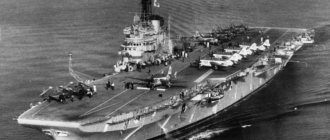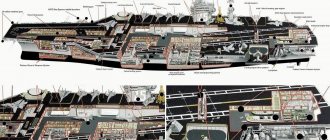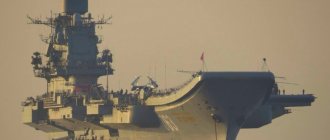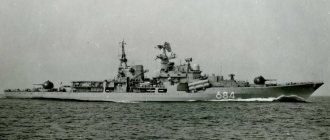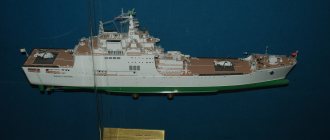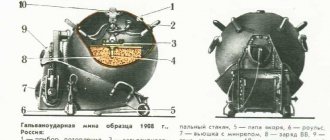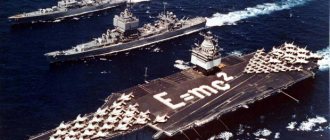Long arms of the fleet
India received its first aircraft carriers from Great Britain, whose role in the creation of the national navy can hardly be overestimated. With independence, the influence of the Royal Navy did not decrease: in addition to traditions and a number of ships of various types inherited from the British, India collaborated with Great Britain for many decades, purchasing both finished ships and designs implemented at national shipyards.
The first Indian aircraft carrier was INS Vikrant, built in 1945 jointly by Vickers-Armstrong and Harland & Wolf shipyards for the Royal Navy under the name HMS Hercules. The ship never became part of the British Navy: in 1946, as part of the post-war reduction of the fleet, it was mothballed. In 1957, the ship was sold to India, and in 1961, after modifications, it became part of the Indian fleet as the Vikrant. A relatively small aircraft carrier with a total displacement of about 20,000 tons carried 20-25 aircraft: Hawker Sea Hawk carrier-based fighters, Breguet Br.1050 Alizé anti-submarine aircraft, American Sea King helicopters ( Sea King) and French Alouette. It was subsequently converted to carry Sea Harrier vertical take-off and landing fighters.
In 1997, 52 years after its construction, the Vikrant, which had served the Indian Navy for 36 years, was decommissioned and permanently moored as a naval museum in Mumbai.
By this time, the Indian fleet already had a second aircraft carrier. The ship, known as INS Viraat, was purchased from the UK in 1986 and arrived in India in 1987.
The former HMS Hermes, a Centor-class light aircraft carrier, was laid down at the Vickers-Armstrong shipyard in 1944, launched in 1953 and transferred to the British Royal Navy in 1959. As part of the Royal Navy, Hermes distinguished herself in the Falklands War of 1982, where she was the flagship of the British carrier force. Larger than the Vikrant (28,700 tons of total displacement), it can carry up to 30-35 aircraft, although usually its air group, like its predecessor, is no more than 20-25 aircraft.
Already in the late 1980s, Indian admirals began to think about the prospect of replacing both aging ships. Initial plans called for the construction of two 28,000-ton aircraft carriers: the first would replace the Vikrant by the end of the 1990s, and the second would replace the Viraat in the mid-2000s. These plans were not implemented due to economic reasons. In 1991, the Defense Expenditure Committee requested that plans for large aircraft carriers be scrapped and that an alternative design be considered the size of the Italian light aircraft carrier Giuseppe Garibaldi, known as one of the smallest aircraft carriers in the world, with a standard displacement of 10,000 and a gross displacement of 13,850. tons
The Indian admirals did not like the idea of replacing the Vikrant and Viraat with ships almost half the size. Nevertheless, the design of a new aircraft carrier capable of carrying 12-15 aircraft began, although the fleet was able to force an increase in displacement to 17,000 tons. In 1997, the Indian Navy almost managed to regain its previous positions: the ADS (Air Defense Ship) project was considered as a promising one - a 24,000-ton ship with an air wing of 20-25 aircraft, based on the project of the French company DCNS.
"Vikrant" (R11)
Photo: indiannavy.nic.in
During this period, the fleet changed its views on the concept of the future ship. Instead of an aircraft carrier designed to host short/vertical take-off and landing aircraft (STOVL scheme), the admirals planned to get a ship capable of carrying full-fledged fighters. These aircraft carriers, built according to the CATOBAR (catapult take-off, landing with the help of aero-finishers) or STOBAR (short take-off with the help of a ski-jump, as on STOVL, and landing with the help of aero-finishers, as on CATOBAR), did not fit into the originally specified size limits. The displacement of the designed ship increased, exceeding 30 thousand tons and eventually settling on the value of 37,500 tons of standard displacement and over 40,000 tons of full displacement.
At the same time, it was clear that the implementation of our own project in such a difficult political climate would take a long time: the order for the first ship of the new Project 71, named Vikrant, was issued in 2004, the keel of the aircraft carrier at the shipyard in Cochin took place in 2009 , the final launch is in 2015, and commissioning, announced for 2018, may be postponed for another 1-2 years. Under these conditions, the leadership of the Indian Navy accepted the Russian proposal to purchase the former Soviet heavy aircraft-carrying cruiser Admiral Gorshkov and rebuild it into an aircraft carrier of the STOBAR design, for basing MiG-29K fighters and helicopters. Negotiations that had been going on since the late 1990s ended in 2004, and in 2013 the ship was handed over to the customer under the name Vikramaditya. At the same time, India received 45 MiG-29K fighters, which should form the air wing of both the Vikramaditya and the new Vikrant.
Photo: Indian Navy
In the late 2000s, when China was working on the aircraft carrier Liaoning (the unfinished heavy aircraft-carrying cruiser Varyag for the USSR Navy) and was planning to create its own Chinese aircraft carrier, India started thinking about building the next ship. According to press reports, he should be named "Vishal" (INS Vishal).
The first nuclear one?
Officially, the new Indian aircraft carrier Vishal is listed as the second ship of the Vikranta class. Nevertheless, the requirements for the project announced by the Indian military mean the construction of a fundamentally new ship.
In 2010, when announcing the start of the design, Indian Navy Chief of Staff Nirmal Kumar Verma explained that the navy wanted a “large aircraft carrier” from which fighters, radar patrol aircraft and tactical refueling aircraft could operate.
To implement these requirements, the Vishal is allowed to use a nuclear power plant; its displacement will increase from 40 thousand to 65 thousand tons. The 40 aircraft planned for Vikrant become 54.
The architecture of the ship is also changing. The trampoline (STOBAR scheme) "Vikrant" turns into a catapult (CATOBAR), equipped with an electromagnetic catapult (EMALS). The springboard may remain, but a smooth-deck option is also being considered.
In this sense, “Vishal” relates to “Vikrant” approximately as the nuclear aircraft carrier of Project 1143.7 “Ulyanovsk” correlated with its predecessors - 1143.5 (“Admiral Kuznetsov”) and 1143.6 (“Varyag”).
Such a ship is obviously redundant for the needs of a traditional confrontation with the Pakistani Navy. The appearance of a large nuclear-powered aircraft carrier with a developed air group in the Indian fleet is a direct challenge to Beijing, Islamabad’s long-time military-political partner.
Since the early 2000s, China has been implementing the so-called “string of pearls strategy,” which involves the deployment of a chain of military bases in the Indian Ocean (including the potential use of the Pakistani deep-sea port of Gwadar, transferred to Chinese control in 2013) and electronic intelligence posts that should if necessary, provide the Chinese fleet with the opportunity to freely operate in a wide arc from East Africa to the Strait of Malacca.
Increasing requirements for the ship, which actually excludes serial construction only on its own, creates a tender situation for foreign developers and completers. A lot of questions arise about the possible division of labor: who will make the nuclear power plant, who will build the aviation-technical complex, who will provide the air group, and who will be assigned the right to install weapons.
Vikramaditya at sea
However, instead of the previously set date (May 25), the aircraft carrier under tugs departed from the Sevmash outfitting wall only on the white night of June 8, 2012.
After being deployed to the roadstead, the ship replenished its supplies of water, fuel and food, and a few days later, under its own power, it headed from the White Sea to the Barents Sea to the areas of the Northern Fleet’s combat training grounds, where it began systematic comprehensive tests. The results initially gave cause for optimism, according to anonymous industry sources. Only after a few days of satisfactory work did troubles creep in one after another. Press service of OJSC PA Sevma
Troubles arose with the KVG-3D boilers (developed by the Special Design Bureau of Boiler Making, SKBK), specially designed to meet the requirements of the general customer. This is a boiler design that was proven for the Soviet fleet, converted to a different type of fuel - diesel fuel (instead of naval fuel oil) with environmental improvements. The Indian side especially insisted on the latter. But, as it later turned out, SKBK did not produce a fully qualified product. Baltiyskiy manufactured nine such boilers, one of which – the first – was tested as a stand at SKBK. According to information leaked to the press, the design of the stand was somewhat different from the serial units, which later became the main source of troubles with Vikramaditya.
The trial launch of the boilers and commissioning of their automation began on the ship almost six months before departure. It was impossible to give the full load to the units at the berth, so all the shortcomings appeared during tests with increasing speed.
In July, at the next exit to the Barents Sea (from the North Sea roadstead, where the aircraft carrier was standing on barrels), when trying to reach full speed, it became impossible to maintain the thermal regime in several boilers - they were automatically taken out of action. As a result, the ship was unable to reach the contractually established speed of 30 knots. During one of these attempts, upon reaching 27.5 knots, the correctly operating automation turned off seven of the eight defective boilers due to exceeding the thermal regime, preventing them from crashing and burning out the gas ducts. As the participants in the sea trials said, during other attempts to reach the maximum steam generation mode, a different number of boilers were turned off each time (both three and five out of eight). At the same time, for small strokes the boilers produced steam.
The commissioning crew specialists tried to fix the problems that arose while still at sea. However, identified damage to the thermal insulation of the boilers (brickwork crumbling throughout the entire boiler group) forced the difficult decision to return the ship to the plant.
In addition to the boilers, other equipment failures were recorded, both mechanically and electronically. The equipment that was installed on the ship at the request of the Indian customer failed. This was stated by the head of USC Alexey Dyachkov, who listed “three refrigeration machines, nitrogen generators and a whole range of equipment supplied from NATO countries.” We were talking about York parking refrigeration machines, reverse osmosis units made in India under a German license, as well as Wartsila diesel engines. According to experts, “this was not critical, but that is also why the mooring and sea trials of the Vikramaditya were not closed.”
However, incidents on board did not lead to loss of power, and even with some of the boilers turned off, the ship ensured a check of the aviation complex.
The senior person on board during all trips to sea was the chairman of the commission for the acceptance of the ship's aviation technical equipment - the deputy commander of the Northern Fleet.
There is a choice, but...
There are not many shipbuilding schools in the world that can compete for the right to become the lead executor of a new aircraft carrier project for India.
The first step is to unfasten the Americans from the project. All that Washington can really do in these conditions is to try to push through the abandonment of the nuclear power plant and under this sauce sell Delhi a converted boiler-turbine aircraft carrier of the Kitty Hawk class (Kitty Hawk) - or the CV-63 Kitty Hawk itself, or CV -67 "John F. Kennedy" (John F. Kennedy). These ships, built in the 1960s, are currently being removed from the fleet to be cut up for metal or converted into museums.
The option is possible, especially if India decides to save money. Another question is that the traditions of the American military-industrial complex almost exclude involvement in integration consortia with competitors, especially Soviet-Russian ones. The situation in which India suddenly wants to place the MiG-29K on the hull of an “American” (with or without Russian aviation-technical complex) is completely chimerical, but it will definitely provide the cheapest of all possible ways to acquire a heavy aircraft carrier.
What about the French? The project of the nuclear-powered ship PA2 (the so-called “second aircraft carrier”), which was supposed to come to the French fleet after Charles de Gaulle (“the first”), is almost suitable for the Vishal’s parameters: after the next reduction, its displacement should be 62,000 tons, and over 40 aircraft will be able to be on board.
Photo: Simon Yang
However, DCNS also has a commercial alternative: for some time now they have been promoting in Brazil the so-called DEAC (DCNS Evolved Aircraft Carrier), which is an export non-nuclear version based on PA2. The ship has a standard displacement of 55,000 tons and carries up to 40 aircraft.
The third and final participant in the race for the “first nuclear” is the Russian Nevsky Design Bureau, whose work is well known to Indians from “Admiral Gorshkov” (“Vikramaditya”). The Italian company Fincantieri has every chance to work with Nevsky PKB. The traditionally good relations between the Italian and Russian defense industries are complemented by the fact that these two companies closely participated in the design and construction of the Vikrant aircraft carrier.
It can be assumed with a high degree of probability that, in accordance with the long-standing traditions of the Indian military, none of the listed applicants will receive a “one person” contract. Most likely, a multilateral consortium will be assembled, in which each of the participants will play a strictly defined role. What might this look like?
“Journalists to hell”, the ship to “Sevmash”
Media reports about the accident on board the aircraft carrier appeared on September 17.
And immediately with a ready conclusion about the complete failure of the tests. To an inexperienced reader it might seem that the failure of part of the boilers on the ship during testing was a very serious “all is lost” style accident... But with the return of the aircraft carrier to Severodvinsk, more sober voices began to sound...
As one of the sailors, who once served a lot on the Vikramaditya’s younger brother, the Russian TAVKR Admiral Kuznetsov, put it: “Just think, several boilers are out of order. We performed tasks on almost one - and nothing!”
It is characteristic that at present USC specialists even express some satisfaction with the “accident”. According to Vasily L., an employee of Sevmash, “it’s even good that some of the boilers and other units “flew” while underway. Nothing failed that would require replacement, unloading or loading, or even the manufacture of new complex systems to replace irreparably broken ones. We should be happy: after all, boiler problems can be easily fixed, and after the repairs are completed, I’m sure all boilers will work as they should.”
“There is no fatal failure of the tests,” Konstantin Z., another participant in the sea trials, expressed his point of view to the Central Military Commission. “Journalists are screwed! The identified limitation on the load on the boilers is not a fiasco, but a reason for further improvement of the ship and its docking.”
Why did this unpleasant incident occur, which could negatively affect the trusting relationship between India and Russia? As it turned out, during the serial production of KVG-3D boilers according to the customer’s technical requirements, the bureau deviated from proven practice and replaced the traditional asbestos cardboard seal (allegedly dangerous to the health of the crew) with environmentally friendly insulation: Chinese-made fire bricks could not withstand this (however, Chinese authorities the sale of such bricks to Russia was denied).
But why did the test boiler pass the test, but the others failed? As representatives of the Special Boiler Design Bureau (SKBK) later admitted through gritted teeth, the first boiler produced at the Baltic Plant had asbestos insulation, but the other eight installed on the aircraft carrier had “advanced” ceramic insulation that had not passed the full test cycle. This is where SKBK and the Baltic Plant “saved”.
